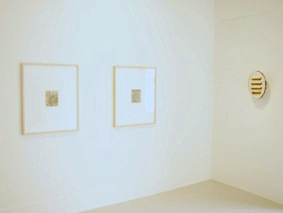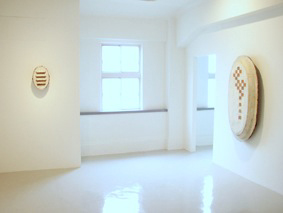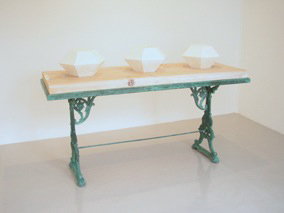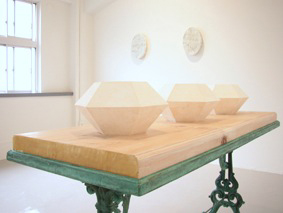yoshinobu nakagawa, "on the table"mar. 29 - may 17, 2003taguchi fine art, ltd. |
|




|
Born in Osaka in 1964, Yoshinobu Nakagawa now resides in Shiga prefecture. Ever since his first one-person show in 1987, the year he graduated from Osaka University of Art, Nakagawa's motif has been consistently plants or relationship between plants (nature) and mankind (farmer), or agriculture and cultivation, which is fundamental work to us. His artisanship, which freely controls every kind of materials and the poetic emotions, when looking at the naive form of his work, attracts many people. This is his second show at taguchi fine art, the first one titled "farmer's pot" in 2001. "the thing sown (the seed)" and "the place where to be sown (the earth)""Farmer's pot" series, the works dealing with the relationship between "the thing being stored (the seed)" and "the thing stores (the pot)", were installed at his last show at taguchi fine art. Then next, his other serial works, "on the table" series, the works dealing with the relationship between "the thing sown (the seed)" and "the place where to be sown (the earth)", are focused at this exhibition.Through the consideration about this relationship, between "the seed and the earth", Nakagawa tries to examine the relationship between "pigment and canvas/paper" or "sculpture and base", which is the issue in the field of fine art. on the tableNakagawa entitled his works "on the table" first around 1992, the works "ridges on the table" and "seed on the table". "Ridges on the table" is a relief sculpture, of which motif is the form of the field and the continuous ridges on it. "Seed on the table" is a painting on a small canvas which had painted and once completed as a painting work by the artist himself earlier. He scrapes the surface of the canvas and removes the layer of the paints, again paints layers and layers on it as farmers cultivate the earth. Then he draws small circles on it using wax soot as farmers sow plant seeds on earth. For Nakagawa, the process of producing art works has something in common with farmer's activity and his physical action.boundary between painting (two dimensional) and sculpture (three dimensional)"Seed on the table" series soon grew beyond two dimensions to three dimensions, relief work which is the ambiguous form as sculpture. This work is constructed with reclaimed paper, cotton cloth being pasted on it. Its oval shape reminds us a dining table. Some cowhide belts are woven in grid form on its surface, making checkered pattern. Each grid represents plant seed.These woven cowhide belts are going into the inside and coming up to the surface of the work, therefore the viewer's concern would be teetered between "the expanse of the flat surface - painting, two dimensional" and "the structure inside - sculpture, three dimensional". Nakagawa, who studied at the painting course at university, having produced and exhibited mainly three dimensional works however, has been seeking for an answer to the question, "what is the essential qualities of painting (two dimensional work)", through the examination of such a moment of the transition from two dimensional to three dimensional and from the three dimensional to two dimensional. The question also leads him to the counter-question, "what is the essential qualities of sculpture (three dimensional work)". Nakagawa finds analogy between the place where artist works and the earth where farmer works, and regards the former as a "table". This is because "table" is not only the familiar thing on which he actually draws and paints, but also has ambivalent character that it exists as a three dimensional object and, at the same time, appears to us as a two dimensional flat plane. free standing sculptureWe can see new developments in the recent works by Nakagawa who has been producing mainly relief works so far.On the occasion of his one-person show at a gallery in Osaka in spring last year, he exhibited the work, "the surface of the water", the motif of which is a flooded rice paddy. This work is regarded as a genuine painting work although its thickness is very much emphasized. Contrary to what people might think, it was his first painting work to be exhibited in his one-person show. In case of his most recent work, "untitled (on the table)", Nakagawa's interest goes to a free standing sculpture independent of walls. Now he is looking for an answer to the question, "what is the essential qualities of sculpture", through creating both base and sculptures on it, which is the first experiment for him. In this work, as is often the case with him, he considered the relationship between the ridges and the farm products on them as the starting point. His point of view is very unique as it was cabbages or Chinese cabbages on the ridges in the field that inspired him to produce this work. The works on view are his most recent work, "untitled (on the table)" and also some related works including "ridges on the table" and "seed on the table". |
| checklist of the installation | |
| 1. "seed on the table 94008", 1994, | |
| oil on canvas, soot, tracing paper, beeswax | |
| 17.3 x 14.2 cm | |
| 2. "seed on the table 94015", 1994 | |
| oil on canvas, soot, tracing paper, beeswax | |
| 17.3 x 14.2 cm | |
| 3. "ridges on the table", 1992 | |
| reclaimed paper, oil on canvas, acrylic, colors, cowhide, string | |
| 38.0 x 27.0 x 26.0 cm | |
| 4. "ridges on the table", 1993 | |
| reclaimed paper, colors, beeswax, string | |
| 32.0 x 23.0 x 11.0 cm | |
| 5. "seed on the table A9601", 1996 | |
| reclaimed paper, cotton, acrylic, cowhide, colors, string | |
| 133.0 x 73.0 x 17.5 cm | |
| 6. "the surface of the water (a round table) #6", 2002-2003 | |
| wood panel, acrylic, cotton, tracing paper, beeswax, canvas | |
| 36.8 x 26.5 x 5.4 cm | |
| 7. "the surface of the water (a round table) #7", 2002-2003 | |
| wood panel, acrylic, cotton, tracing paper, beeswax, canvas | |
| 36.8 x 26.5 x 5.4 cm | |
| 8. "untitled (on the table) #1", 2002-2003 | |
| plaster, wood, bronze, beeswax, colors | |
| 99.5 x 159.5 x 61.3 cm | |